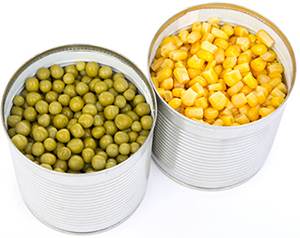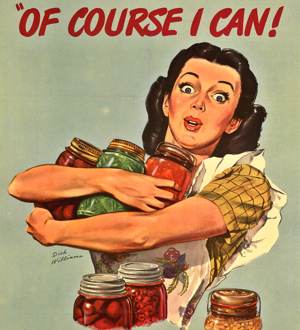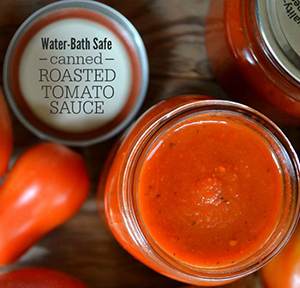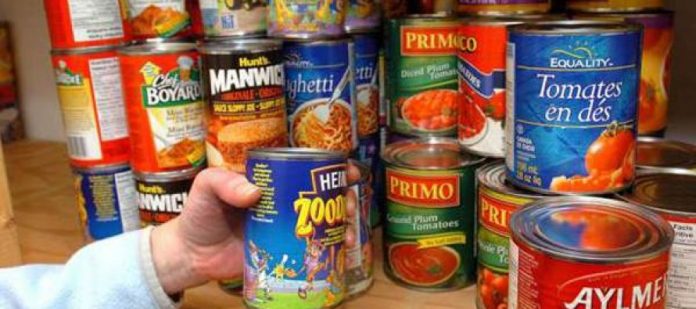When we think about preparing for survival, one of the first things that come to mind is storing away food and for most people what comes to mind first is canned food. Canned food is readily accessible, easy to store, and budget-friendly. But there are a number of myths that are being passed around about canned food and these myths can easily be confused with facts. Sometimes, these myths cause people to think twice about whether canned food is the best choice as a way to store food away from bad times.
We are here to straighten the record. In general, we reveal the top myths about canned food followed by the myths and facts about canning your own food. All of this will then be placed in the context of canned food preparations and long-term storage.
General Myths and Facts
 Myth #1: Canned foods are loaded with preservatives
Myth #1: Canned foods are loaded with preservatives
No! The canning process renders the use of preservatives unnecessary. Canned food is heated to a temperature and pressure sufficiently high to kill any bacteria that would pose a threat. The fruit has a high level of acidity which allows it to be canned with only the need for high heat, but other foods, including vegetables, beans, and meats, are placed under high heat and pressure to be able to. Nothing is added to the food except sweeteners or seasoning required. As the food is canned, it forms an airtight seal that keeps the bacteria out and freshness in.
Myth #2: Canned foods are not nutritious compared to fresh or frozen
It’s definitely true that fresh food is the most nutritious. The earlier it is consumed after processing or killing, the greater the food’s nutritional value. Cooking from some foods can also cause some nutritional losses. Nevertheless, canned foods retain the majority of their nutrients, particularly those that are canned close to harvest.
Canned foods retain their full fiber and protein content, carbohydrates, and fatty acids have negligible effects and some vitamins suffer only minor losses. Certain fruits and vegetable canning actually increase their nutritional impact. When canned tomatoes have a higher lycopene level; a variety of vegetables, such as carrots and spinach, have higher carotene levels; and other fruits and vegetables have greater antioxidant quality.
Myth #3: Canned foods are processed foods
If you are thinking about it, you will be processing it as soon as you cook some food. Roasting a chicken, boiling potatoes, and baking bread are all ways to turn the food into a shape we can/prefer consuming it. In fact, canned food is no more processed than standard cooked foods. The main difference is that they are cooked at higher temperatures and pressures, and then sealed with a vacuum.
Myth #4: Canned food tastes bad
Let’s just face it. The taste of a can of peaches is enchanting. Yum! Canned foods maintain their flavor at least until their expiry date when canned at the height of ripeness and soon after harvest, and longer if properly stored in a cool, dry environment.
Myth #5: Canned food has a high sodium content
It’s true they also have salt in canned foods. However, this is not needed for such foods for canning and preservation. Salt is added just as you’d add salt to your French fries or a bowl of soup just for the sake of flavor. As for canned foods, there are plenty of low-sodium options.
Myths and Facts about Canning Your Own Food
The above myths and reality are usually about packaged food, and what you’re purchasing off the grocery store shelves, but other people prefer to get their own food. Perhaps they’re growing a garden or they’re looking for bulk produce on sale and then they want as much of it as they can. Knowing what you do when you canned your own food can mean the difference between nutritious and delicious food and food that will make you deadly ill. Here are some myths and facts about canning your own food.
 Myth #1: Vegetables can be canned in a hot water bath canner; simply boiling them long enough will make them safe for consumption
Myth #1: Vegetables can be canned in a hot water bath canner; simply boiling them long enough will make them safe for consumption
The fact is only foods that are high in acidity can be canned simply by boiling them. This ensures that fruit can be canned in a water bath canner (attaining 212 °F), but low-acid foods like potatoes, beans and legumes, meat, and dairy must be canned with a pressure canner. These low-acid foods can cause botulism which is a food-borne disease caused by spores that can kill Clostridium botulinum. The high pressure of the pressure canner will raise the canning bath temperature to 240° F, effectively killing off the spores of Clostridium botulinum.
Myth #2: You can safely can food in your oven
Absolutely not. Canning food in your oven is not safe, especially when it comes to those low-acid foods we talked about above.
 Myth #3: Any salsa recipe can be canned in a water bath canner
Myth #3: Any salsa recipe can be canned in a water bath canner
This is not true, since it depends on your salsa ingredients. If the salsa contains too many low-acid foods then a pressure canner is required. Also, salsa recipes that are designed for water bath canning should be used and followed with precision.
Myth #4: Vegetables don’t need to be blanched prior to canning
If you want canned vegetables with good color, taste, and texture, then it is highly recommended that you blanch them, which means that they will be exposed to boiling water for a short time. This deactivates enzymes on the surface of the vegetables which will cause discoloration and changes in texture and flavor.
Myth #5: You can use any jars for canning
You can’t use just any canning jar. While glass mayonnaise jars can be used, they are not the safest. The easiest and safest jars to use are modern lids made from mason jars. You can reuse the jars and rings (screw bands) but for each canning session, you have to buy new lids.
Myth #6: Paraffin wax is adequate to seal jams and jellies
This is not the case. Paraffin wax will not create an airtight seal on a container. This means bacteria can still get in and the preserves can spoil.
Myth #7: Very high-acid foods, such as pickles, do not need to be put in a water bath canner
No matter how acidic food is, it requires the recommended amount of time in the water bath canner. This is because there are some yeasts and molds that will survive even in a high-acid environment and the only way to kill them is via high temperatures.
Myth #8: You have to make the rings on mason jars super tight
The rings on mason jars only need to be tightened fingertip tight; you don’t need to use your muscles to get them really tight. The seal is formed by the lid and if the ring is too tight, it can cause the seal to fail.
Canned Goods and Prepping
Now that you are familiar with the truth about canned goods and canning your own food, let’s finish off with a look at adding canned food to your stores. Canned food is an excellent and cheap way to store extra food away, but some people think that’s all they need. Stocking other non-perishables, such as rice, dried beans, pasta, dried fruit, trail mix, seasonings, and honey, is nevertheless prudent. This will give you more choice, something that’s really necessary in difficult times.
Even if canned foods have an expiry date, they’re still good long after that date has come and gone, particularly if the food has been stored in a cool, dark, dry environment. Even so, rotating the stores is safest, using older food and adding fresh food to the shelf‘s back. Be sure to dispose of any dented or very rusty canisters.
Altogether canned food is an essential part of your overall planning program. Buy them on sale, and get what you think your family is eating. Any of which you can turn into a hot meal (such as soups and beans), you’ll have fine, nutritious food. Plus you can eat it straight from the can in a pinch. And don’t forget to stock up on a few can openers! You’ll need these!











